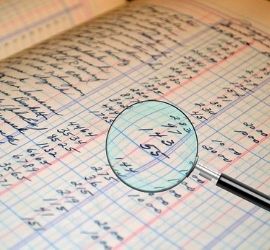What Is a Ledger Balance?
 A ledger balance is usually computed by a bank at the end of each business day. It includes all withdrawals and deposits to calculate the total amount of money in a bank account. In many cases, it is also the opening balance in the bank account the next morning and remains the same all day.
A ledger balance is usually computed by a bank at the end of each business day. It includes all withdrawals and deposits to calculate the total amount of money in a bank account. In many cases, it is also the opening balance in the bank account the next morning and remains the same all day.
Ledger Balance – A Closer Look
The ledger balance represents the aggregate whole of account funds available for customer use. It includes any outstanding checks as well as any pending deposits that haven’t yet been authorized for use. There is some confusion between ledger balance and available balance. Many people mistakenly think that their available balance is their ledger balance, but that is not always the case. Often, available balances fall into two categories:
- A ledger balance that’s adjusted for any activity during the day, or rather, the ending balance.
- A ledger balance that excludes any pending deposits and credits that are withheld for some reason or have not yet been posted.
Remember, the ledger balance is the beginning balance rather than the end balance. On the other hand, most available balances are calculated as the end balance. Therefore, it is incorrect to assume that they are one and the same. Many online and mobile banking services do not always display the most up-to-date information in real-time.
Additionally, bank statements alone cannot be relied upon. Bank statement balances are taken from ledgers at the time that the statement is issued. However, any activity that has occurred after the statement was issued impacts the bottom line. It is best to keep track of your own income and expenses to know where your actual balance is at all times. Failure to do so may result in an overdraft, which could be costly and embarrassing. (Source: bankrate.com)
How a Ledger Balance Works
The ledger balance is the opening balance reflected in the bank account at the beginning of a business day. It remains unchanged for the entire day. The bank calculates it at the end of every business day, and it includes both debit and credit transactions. It is different from the memo balance and the customer’s available balance. It is always vital for account holders to keep their records up to date. In most cases, the bank statements and online banking totals do not reflect the most current information.
Throughout the business day, transactions are approved and processed. Banks then calculate the current balance after posting all transactions such as deposits, interest income, and wire transfers. They will also include cleared checks, cleared credit card or debit transactions, and any correction of errors. The final tally represents the existing balance on an account at the onset of the next business day.
Processing delays can often occur related to pending deposits. Banks must first receive funds from the financial institution of the person or business who issued the check. This holds true for wire transfers or other forms of payment. Once the funds clear, the money is made accessible to the account holder as reflected in their available balance.
The bank statement only provides the current balance as of the particular date the statement was prepared. Deposits made and checks written on or after this date do not appear on the statement. The ledger balance may be used to determine whether the requirement to maintain a specific minimum balance is being satisfied. It is also included in bank account receipts. For all these reasons, the ledger balance usually differs from the available balance of the bank account.
Ledger Balance vs. Available Balance
The ledger balance often differs from the customer’s available balance. An available balance represents the aggregate funds accessible for withdrawal at that point. But, the ledger balance is calculated at one time and then remains the same throughout the day. As a result, it does not include real-time transaction updates. However, the available balance changes frequently. This is to reflect transactions that clear the bank account throughout the day. Neither balance includes outstanding checks just written from the account. But, the available balance updates for recent automated teller machine (ATM) withdrawals, deposits, and other transactions as the information is received by the bank.
To properly plan your finances, it is important to understand the difference between these two balances. After viewing only the ledger balance, an account holder may withdraw more money than is actually available. This may lead to bank overdraft charges as well as fees from the other party’s bank or business. Also, monitoring balances on a regular basis will alert a customer of any unauthorized transactions or potential errors committed by the bank.
Ledger vs Available balance
The ledger balance and available balance are terms used by a bank for the cash position of a checking account. The ledger balance is the balance available at the beginning of the day. The available balance may be defined in two different ways:
- The ledger balance, plus or minus any subsequent activity during the day. Essentially, it is the ending balance at any point in time during the day.
- The ledger balance, minus any checks deposited but not yet made available for the use of the account holder. Additionally, any other credits not yet been posted to the account.
The latter definition is more commonly used. In most situations, the primary difference between the two balances is a result of processing time. The time it takes for checks that a company or individual has deposited, but which the bank has not yet made available for use. This delay occurs because the bank must first be paid by the financial institution that issued the check. Once the funds have been transferred, the cash will be made available to the account holder. Banks may delay the availability of this cash to the account holder, thereby earning interest on the withheld cash. (Source: accountingtools.com)
Ledger vs. Memo Balance
Ledger balance takes into account all the financial transactions received by the end of the day. These include cleared checks and finalized debit card transactions that are officially posted. On the other hand, the memo balance shows the account balance. However, it updates all totals as the financial items hit the holder’s bank account throughout the business day.
Importance of the Ledger Balance
As stated above, the current balance is the balance at the beginning of the day. When you log into your mobile or online banking, you may not see the most updated information. Some banks display both the current and available balances. This is so customers can tell how much money they have vs what has cleared and is available to use.
Bank statements should be reviewed closely. Balances displayed on statements are taken from a ledger balance on the statement date. As a result, if you conduct any transaction after the statement date, it will affect your available balance. This includes deposits, withdrawals, and written checks. The best way to ensure you’re working with the most updated balance at all times is to keep your records up to date. For a checking account, you should always keep your own ledger. It provides a running total of your balance after considering any and all transactions running through your account.
Overdrawing Your Account
Do not rely entirely on your current balance. If you spend more than you have in your account, you will likely face overdraft fees or other monetary penalties. This occurs when you bounce a check by writing it for more than is in your account. For that reason, is a good idea not to write checks relying on your ledger balance. Sometimes, the pending credits take longer than you expect to fully post to your account. If there is any sort of problem with a check you’ve deposited, your available funds may not be sufficient.
Example
Let’s assume you start the week with $2,000 in your checking account. Next, assume you get paid $3,000 on the 15th of the month. Under these circumstances, your ledger balance will be $2,000 all day on the 15th. However, the $3,000 you are paid may or may not show in your available balance that day. It depends on how quickly the check clears after the payment is received. Either way, your ledger balance will not reflect a $5,000 balance until the next morning – at the earliest.
Final Words
To summarize, a ledger balance is calculated at the end of each business day by a bank. It is also known as the current balance. It includes all debits and credits at that point in time. In many cases, it is the opening balance the next morning and remains the same all day. The ledger balance usually differs from the customer’s available balance. The available balance is updated throughout the day. It reflects the aggregate funds available for withdrawal at any given point.
Day trading can be summarized simply as buying security. Then, quickly selling or closing out the position within a single trading day. Ideally, day traders want to “cash-out” by the end of each day with no open positions This lets them avoid the risk of losses by holding security overnight. Day trading is not for everyone and carries significant risks. It requires an in-depth understanding of how the markets work and various strategies for profiting in the short term. Short-term profits require a very different approach compared to traditional long-term, buy and hold investment strategies.




